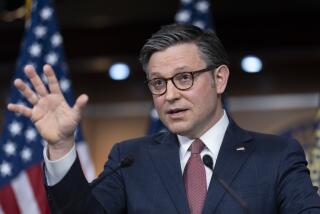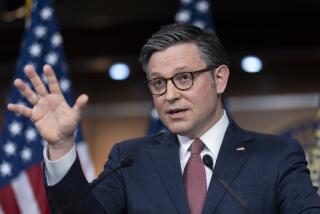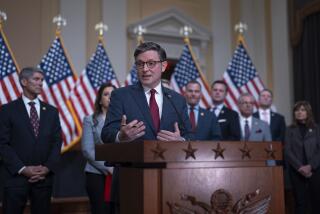Negotiations spark hope for end to government shutdown
WASHINGTON — The impasse over government spending gave way Friday to a steady stream of negotiations, as White House officials and Republicans in Congress wrestled over the details of an agreement that would reopen government agencies and avoid a federal default.
In phone calls and a White House session, President Obama and Republican lawmakers worked to hash out a plan to restore government funding and lift the debt ceiling, and also initiate a new round of budget and deficit-reduction talks.
But the task of sealing a deal was complicated by division between Senate and House Republicans, who were conducting separate negotiations. The White House also said it had concerns over the outline of the House GOP proposal. That plan for a short-term suspension of the debt limit, officials warned, seemed guaranteed to set up a renewed confrontation next month.
Still, for the first time in the 11-day shutdown, lawmakers expressed optimism that a deal could be reached in the next several days. Meanwhile, the calendar crept closer to Oct. 17, when the Treasury Department has said the government will no longer be able to borrow money to cover expenses and could risk a default.
“I just have a sense over the weekend some significant jelling is going to take place,” Sen. Bob Corker (R-Tenn.) said, speculating that a plan could be in place “potentially as early as midweek.”
The qualified hopefulness was a striking shift after days of deadlock in Washington. The two parties have traded barbs and charges of extortion, while many government services remained closed. Federal workers in some agencies received partial paychecks Friday, reflecting the first week of furloughs.
Under pressure to avoid a default and watching the standoff take a toll on their public approval numbers, Republicans on Thursday offered to extend the debt limit for six weeks, dropping their refusal to lift it before the president committed to negotiations over the budget. Late Thursday, after more discussions with the White House, Republicans added a proposal to reopen the government — at least temporarily.
The House GOP proposal would launch a two-track negotiation over at least the next six weeks, officials said.
On one track, in return for temporarily lifting the debt ceiling, Republicans want a series of talks focused on tax reform, as well as cuts to Medicare and other entitlement programs.
On the second track, House Republicans would reopen the government if the White House agreed to talks on spending levels for the current fiscal year, which started Oct. 1.
Both parties would like to make changes to the next round of across-the-board cuts, the so-called sequester, that are scheduled to kick in Jan. 1.
But House Republicans were still insisting on an upfront concession from the president before they moved to reopen the government. Late Friday, House Republicans were still debating what that might be, but it could include slight changes to the healthcare law. Senate Republicans, meanwhile, proposed their own endgame.
Congressional Democrats seemed content to sit back and allow Republicans to argue among themselves, betting that, with the GOP increasingly anxious to end the standoff, Democrats’ leverage will only increase as the debt-limit deadline draws closer.
Senate Majority Leader Harry Reid (D-Nev.) was expected to move forward with a proposal for a one-year extension of the debt limit with no strings attached. A key test vote in the Senate was set for Saturday.
Friday, however, saw no legislative progress, only deliberations behind closed doors.
Senate Republicans boarded buses for a midday meeting at the White House. During the 100-minute session, Sen. Susan Collins, a moderate Republican from Maine, outlined a proposal to fund the government for six months and raise the debt limit for a short term, repeal the tax on medical-device makers, and give
federal agencies the flexibility to manage the sequester budget cuts imposed by Congress early this year.
Collins said Obama liked some of her proposal but was noncommittal. “He described it as constructive and having elements of it that could be worked on, but I don’t want to give the impression that he endorsed it and said, ‘What a great plan,’” she said.
House Republicans opposed Collins’ plan, arguing that it cedes too much control over the budget to the president. That split has left Obama in a negotiation triangle with Republicans in the two chambers. It was not immediately clear whether the White House would embrace either Republican proposal.
White House Press Secretary Jay Carney on Friday did not shoot down the possibility of delaying the medical-device tax, a change to the healthcare law that could draw bipartisan support. He would not commit to other elements of the proposal.
Obama has said he would sign a short-term debt ceiling extension, but Carney stressed that such a deal would keep the president from achieving his key objective: ending the cycle of repeated budget crises.
“We cannot have a situation where the debt ceiling is extended as part of a budget negotiation process for only six weeks, which would put us right back in the same position that we’re in now,” Carney said.
On that front, there was some bipartisan agreement.
A six-week debt limit extension “doesn’t make a lot of sense,” said Sen. Johnny Isakson (R-Ga.). “Because all we would be doing is putting the same problem off for six weeks, and then you have the Thanksgiving cliff. This is the Halloween cliff. So we might as well stop having so many cliffs — which is why everybody started talking.
“I think there is a majority of the House and Senate that realizes it is time to get the government back open,” he said.
Isakson, who helped organize dinners at the White House to discuss the country’s debt burden, said Friday’s meeting was a “good exchange of ideas.” Obama was “very engaged” and “candid,” he said.
After weeks of trading tortured metaphors and allegations of hostage-taking, the rhetoric on both sides softened. That was perhaps the clearest sign of progress.
“It was the kind of meeting you’d expect when you are starting to get down to business,” Isakson said, adding that there was “no showboating.”
At the White House, Carney called the talks constructive. “There needs to be continuing discussions,” he said, “and we’ll see where we get.”
kathleen.hennessey@latimes.com
Brian Bennett and Christi Parsons in the Washington bureau contributed to this report.
More to Read
Start your day right
Sign up for Essential California for news, features and recommendations from the L.A. Times and beyond in your inbox six days a week.
You may occasionally receive promotional content from the Los Angeles Times.









